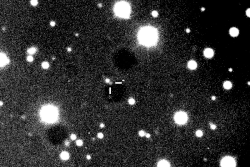Taygete (moon)
Taygete /teɪˈɪdʒɪtiː/, also known as Jupiter XX, is a retrograde irregular satellite of Jupiter. It was discovered by a team of astronomers from the University of Hawaii led by Scott S. Sheppard, et al. in 2000, and given the temporary designation S/2000 J 9.[1][6][7]
 Taygete imaged by the Canada-France-Hawaii Telescope in December 2001 | |
| Discovery[1] | |
|---|---|
| Discovered by | Scott S. Sheppard et al. |
| Discovery site | Mauna Kea Obs. |
| Discovery date | 25 November 2000 |
| Designations | |
Designation | Jupiter XX |
| Pronunciation | /teɪˈɪdʒɪtiː/[2][3] |
Named after | Τᾱϋγέτη Tāÿgetē |
| S/2000 J 9 | |
| Adjectives | Taygetean /ˌteɪədʒɪˈtiːən/[4] |
| Orbital characteristics [5] | |
| 23360000 km | |
| Eccentricity | 0.252 |
| −732.2 days | |
| 317.9° | |
| Inclination | 165.2° |
| 313.3° | |
| 241.1° | |
| Satellite of | Jupiter |
| Group | Carme group |
| Physical characteristics | |
Mean diameter | 5 km |
| 21.9 | |
Taygete is about 5 kilometres in diameter, and orbits Jupiter at an average distance of 22,439,000 km in 686.675 days, at an inclination of 165° to the ecliptic (163° to Jupiter's equator), in a retrograde direction and with an eccentricity of 0.3678.
It was named in October 2002[8] after Taygete, one of the Pleiades, daughter of the Titan Atlas and mother of Lacedaemon by Zeus (Jupiter).
It belongs to the Carme group, made up of irregular retrograde moons orbiting Jupiter at a distance ranging between 23 and 24 Gm and at an inclination of about 165°.
References
- IAUC 7555: Satellites of Jupiter Archived 2002-09-16 at the Wayback Machine 2001 January 5 (discovery)
- Noah Webster (1884) A Practical Dictionary of the English Language
- "Taygete". Dictionary.com Unabridged. Random House.
- There is also 'Taygetian', but that's for Taygetus.
- S.S. Sheppard (2019), Moons of Jupiter, Carnegie Science, on line
- MPEC 2001-A29: S/2000 J 7, S/2000 J 8, S/2000 J 9, S/2000 J 10, S/2000 J 11 2001 January 15 (discovery and ephemeris)
- MPEC 2001-T59: S/2000 J 8, S/2000 J 9, S/2000 J 10 2001 October 15 (revised ephemeris)
- IAUC 7998: Satellites of Jupiter 2002 October 22 (naming the moon)